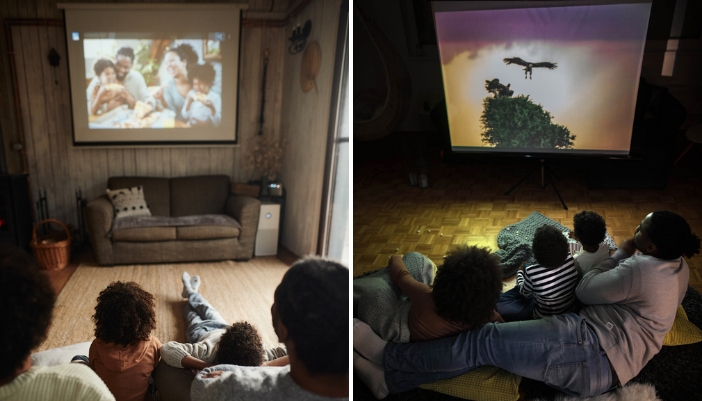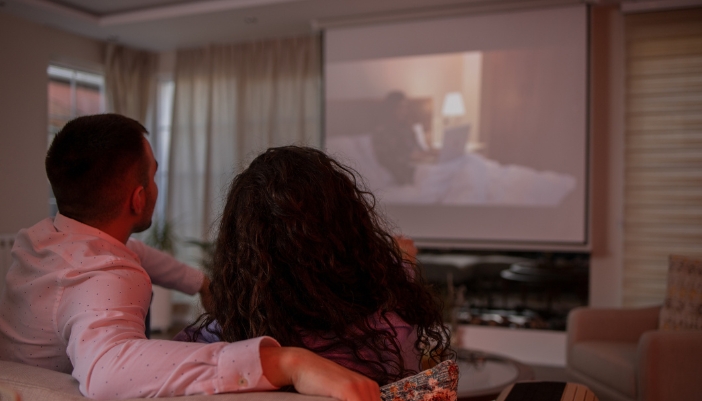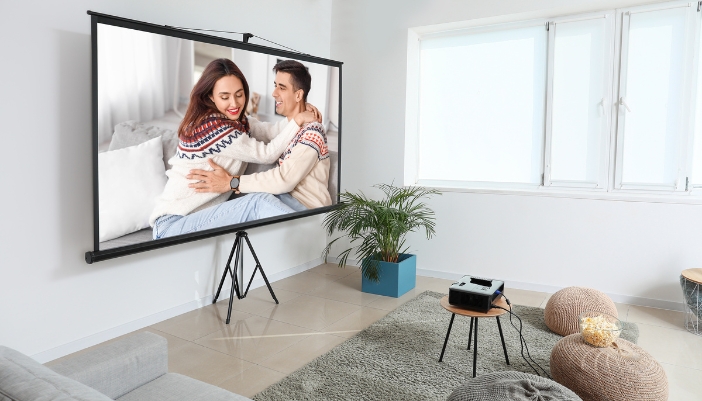Have you noticed how some projector screens look brighter and clearer? It's not just the projector; the screen matters a lot, too. And while the type of screen is a major factor, there’s a vital component you shouldn’t overlook — screen gain!
Screen gain measures how much light a screen reflects, affecting the brightness of the image. It's measured in simple units like 1.0 or 2.0, showing how much light is reflected compared to a basic whiteboard. Typically, the higher the gain, the more vivid the image — but there’s so much more to screen gain than that!
Let’s explore what you need to know for a better viewing experience!
Choosing the Right Screen Gain for Your Needs

When picking the right projector screen, understanding the types of screen gain is crucial. Different gain levels can drastically change your viewing experience, so let’s break down the options.
- Low Gain Screens (0.5 to 0.9): These reflect less light, resulting in darker images, which suit dark rooms or setups with very bright projectors. They feature glare and uniform images but can appear too dim in well-lit rooms.
- Neutral Gain Screens (1.0 Exactly): They reflect light evenly, true to the projector's output, making them ideal for most projectors. These have balanced brightness and color accuracy, with versatility for different lighting conditions, except they’re not optimal in places with lots of ambient light.
- High Gain Screens (1.1 to 2.5): These reflect more light, making images brighter and more vivid, which is ideal for rooms with ambient light, large rooms, or setups where viewers are seated closer to the screen. They make colors pop but are prone to glare and hot spots if not viewed straight on.
Influencing Factors

While the numbers matter for screen gain, a few other factors can majorly influence the impact of how well a screen performs in your setup!
- Material of the Screen: The material mattress is matte white and usually has neutral gain, providing balanced brightness and color accuracy, whereas glass beaded offers high gain, and silver or grey screens boost blacks and contrast (but they might slightly alter color balance).
- Screen Surface Coating: High gain screens often have reflective coatings that boost brightness, making them ideal for rooms with lots of ambient light. Matte coatings, however, help diffuse light and provide a more even image in darker environments (but it results in lower gain).
- Ambient Light Conditions: For dark rooms, low gain screens better maintain comfortable brightness without washing out the colors. Meanwhile, for lighter rooms, high-gain screens reflect more light and keep the image clear and bright.
- Viewing Angle: For viewers sitting directly in front of the screen, high gain screens work best because they reflect more light. But for a wider array of seating arrangements, low gain screens are ideal!
Screen Gain in Different Settings

Where you view your projector is also vital in finding the best screen gain! For instance, in home theaters where you control the lighting, a neutral gain screen provides balanced brightness and color accuracy. However, for completely dark rooms, a lower gain will provide a more cinematic experience.
For outdoor setups, high gain screens are essential to ensure the image stays bright despite varying lighting conditions. In the evening or at night, a gain of around 1.5 is sufficient to keep the picture quality consistent!
Pro Tip:
Rooms with a lot of ambient light work best with 1.1 to 1.3 screen gain to help maintain image brightness!
Choosing the Perfect Screen Gain for Your Setup

Understanding screen gain is just the beginning. Now, let's dive into how to choose the right screen gain based on specific aspects of your setup.
- Projector Brightness:
- Low Brightness Projectors (under 2000 lumens): These projectors need high gain screens (1.5 to 2.5) to boost image clarity.
- Medium Brightness Projectors (2000 to 3000 lumens): Opt for neutral gain screens (1.0 to 1.5) to balance brightness and color accuracy.
- High Brightness Projectors (over 3000 lumens): Use low gain screens (0.8 to 1.0) to prevent the image from appearing too bright and washed out.
- Room Size and Setup:
- Small Rooms: Higher gain screens (1.2 to 1.5) can enhance image brightness even in close seating arrangements.
- Large Rooms: Neutral gain screens (around 1.0) ensure consistent brightness and color accuracy for viewers at different angles.
- Wide Viewing Angles: Lower gain screens (0.8 to 1.0) provide better image consistency across various angles, avoiding hot spots.
- Usage Purpose:
- Movies: For a cinematic experience in dark rooms, lower gain screens (0.8 to 1.0) enhance contrast and color depth.
- Presentations: In rooms with ambient light, higher gain screens (1.2 to 1.5) keep images bright and readable.
- Gaming: Gamers benefit from screens with a gain of 1.0 to 1.2, balancing brightness and color accuracy for clear, vibrant visuals.
The Final Frame
As you can see, screen gain is more important to your viewing setup than you ever realized — the right screen gain can elevate your visuals from dull to dazzling! So, the next time you're shopping for projectors at Jones Appliance and TV, don't forget to consider the screen gain for a truly immersive experience.
Have questions? Our team is always available to answer, whether you call or stop by!